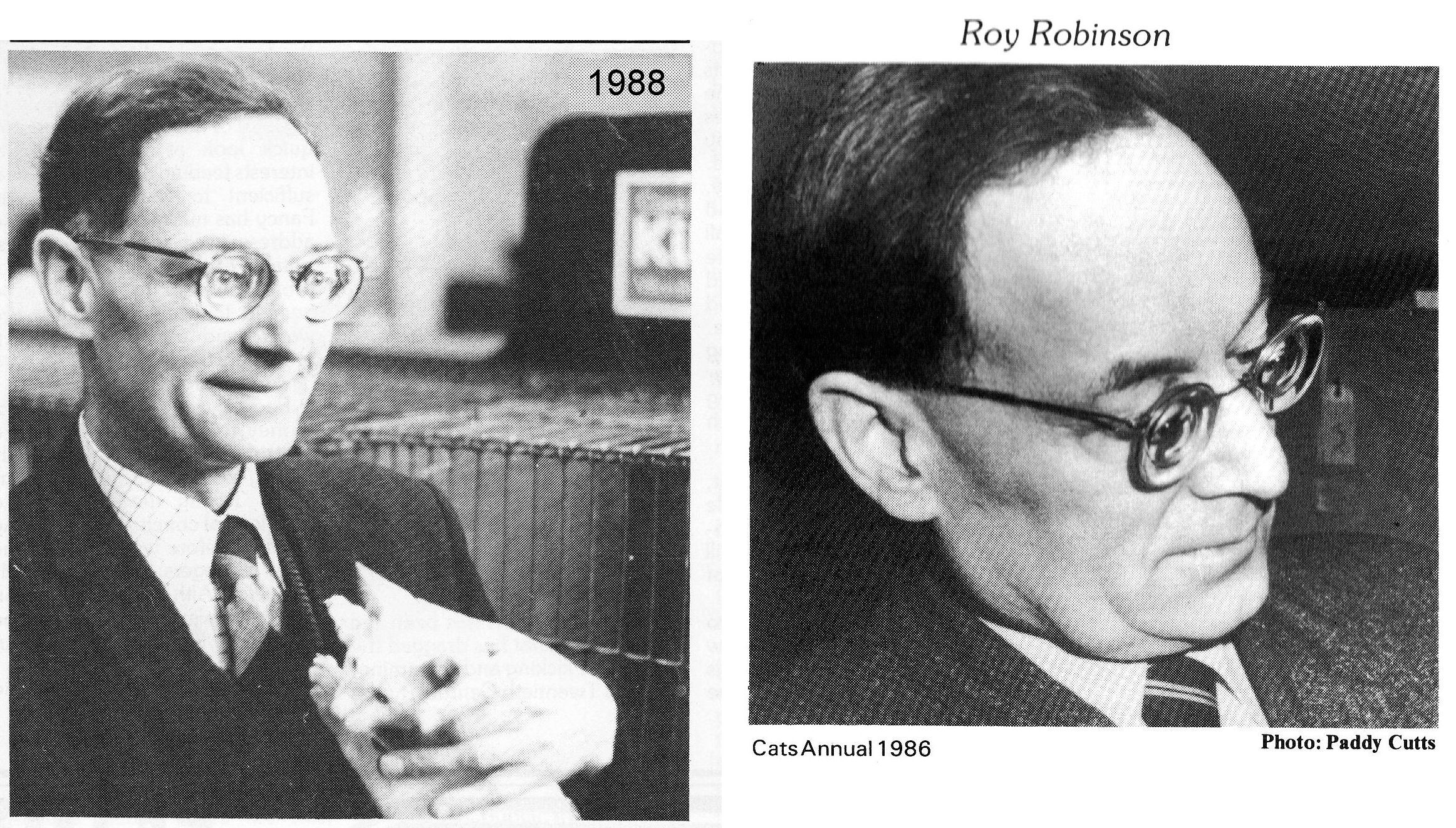
ROY ROBINSON FIBiol (GENETICIST)
ROY ROBINSON FIBiol (GENETICIST)
Although not a cat fancier, geneticist Roy Robinson deserves inclusion in the cat fancy history archive for his contribution to cat genetics knowledge.

Roy Robinson's name is well-known to most cat breeders. His "Genetics for Cat Breeders" ran to 4 editions (the 4th being posthumous) and though not the first book on cat genetics, it was the most comprehensive. Not everyone found his "textbook" style accessible, but his books were thorough with copious references to source material. While modern geneticists have access to DNA analysis and tools to identify mutations, Robinson had to rely on breeding experiments, observation and meticulous recording of results.
OMIA - Online Mendelian Inheritance in Animals (University of Sydney) wrote "As many of you will know, 2022 is the bicentenary of Mendel's birth, on 20th (according to his birth certificate) or 22nd July (according to Mendel and his family) in 1822. 2022 is also the centenary of the birth (on 14 December 1922) of Roy Robinson, a pioneer of Mendelian inheritance in animals. OMIA will join many others in marking both these anniversaries this year."
I only met him once, at a cat show in Olympia, London in conjunction with a book about the Ragdoll cat. I corresponded with him a few times about wild/domestic hybrid cats, sending him clippings about supposed Bobcat hybrids bred in the USA. He was quiet and unassuming, with round-rimmed spectacles. He was very enthusiastic about genetics, and confident of his own knowledge and abilities (he was unimpressed by Solveig Pflueger regarding one cat-related topic in a letter, though I forget what). My few letters from him appeared typed on and sent in - whatever paper was closest to hand.
He disliked travel and rarely strayed outside of London so I never saw him at any of the cat conferences I went to. He enjoyed scientific conferences once there, but mostly relied on correspondence, which in those days was by letter (I think he may eventually have had an email address).
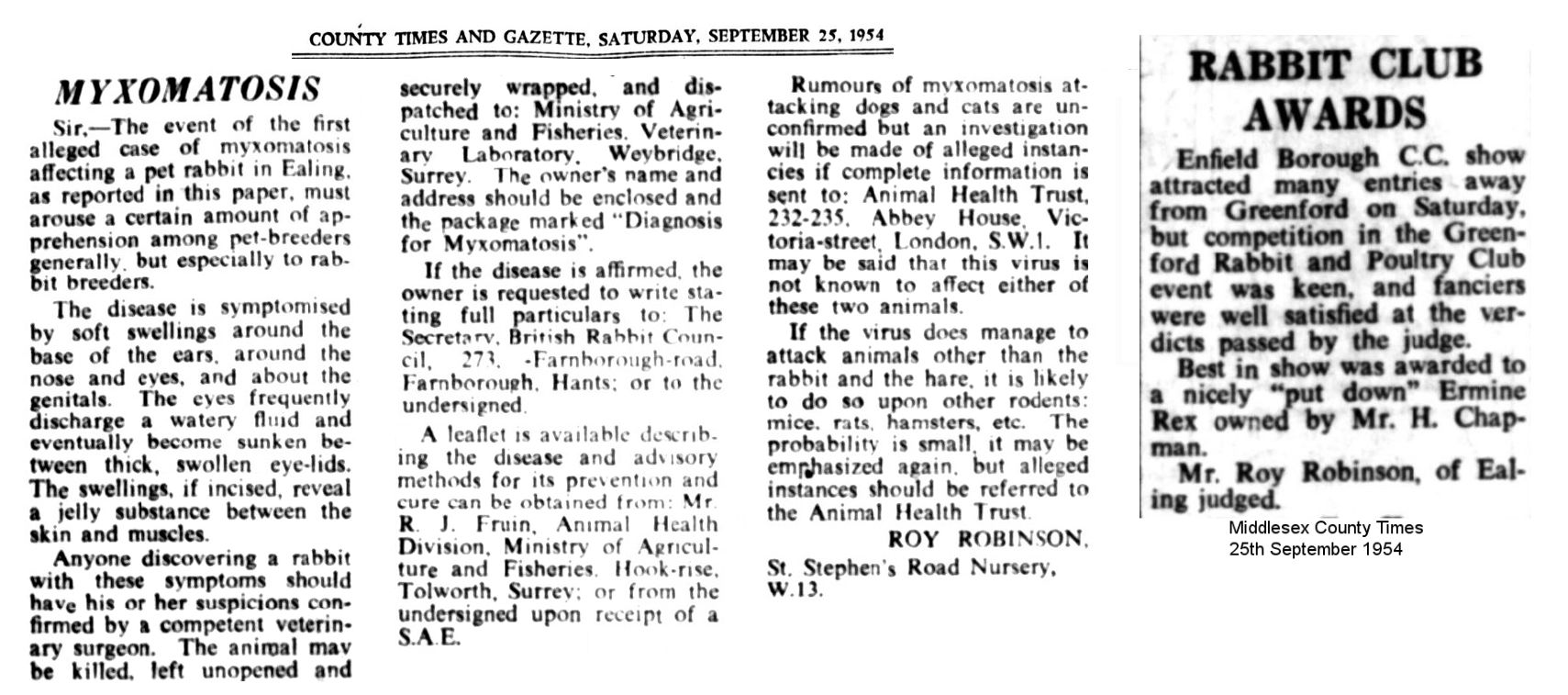
A SELF-TAUGHT SCIENTIST
Though his genetics papers are now well-known, it is surprisingly hard to find information about the man himself. The only published interview seems to be that in the New Scientist of 16th June 1977. Compilers of animal fancy history and other geneticists search in vain for details of his academic background because he was entirely self-taught.
His knowledge was PhD level and many authors quoting his work have assumed him to be Dr. Robinson or Professor Robinson. (In the UK, a professor has a PhD. In North America a professor is an academic employed to research and teach in universities.)
For example, the editor of "Biology of the Laboratory Rat" attributed the opening chapter, "Taxonomy, Genetics and Natural History" to "Dr R. Robinson," assuming Robinson to have academic qualifications. The same happened in 1982 in "Pig genetics: a review" by L. Ollivier & P. Sellier in "Annales de g n tique et de s lection animale" which thanked "Dr Roy Robinson, Ealing, G.B."
Ray Wigley in "The Singapura: Singapore's Love Cat" (2010) also referred to Dr. Robinson in his book (Wigley also wrongly stated the 3rd Edition of "Cat Genetics" was finished after Robinson's death; it is the 4th edition that was posthumous and completed by other authors).
Manuel Ruiz-Garcia and Diana Alvarez wrote "This work is dedicated to the memory of Dr. Roy Robinson and those small friends who accompanied us during years." ("A biogeographical population genetics perspective of the colonization of cats in Latin America and temporal genetic changes in Brazilian cat populations" in Genetics and Molecular Biology p772-782 (2008)).
Amy Fernandez wrote in the "Operations Manual for the Chinese Crested": "The most accurate and revealing study was conducted by the famed British researcher Dr. Roy Robinson in the 1980s." (2011) and this was repeated in "Die Hunde der Chinese Crested, Viringo und Xoloitzcuintle" by Simone Neusuess, ?Luis Tovar Schoener (2018): "Die genaueste Studie wurde dann von dem britischen Forscher Dr. Roy Robinson in den 1980er Jahren durchgefuhrt".
In contrast, Christopher M. Kelty (Institute for Society and Genetics, UCLA, California, USA) demeaningly described Robinson not as a geneticist or Fellow of the Institute of Biology, but as a Lab Technician: "Most biological newsletters have served two overlapping communities: scientists interested in a particular model organism, and the technicians who managed or handled those organisms. Some newsletters show this difference more acutely, as in the case of the Carnivore Genetics Newsletter run by amateur fancier and lab technician Roy Robinson" ("This is not an article: Model organism newsletters and the question of open science.'" (BioSocieties (2012) 7, 140 168.)
EDUCATION, HORTICULTURE AND HAMSTERS
Robinson was born on 14th December 1922 and left school aged 14 to work at his father's nursery garden business on a smallholding in Ealing. He had no formal education after leaving Drayton Primary, Middlesex, which had a very poor record for academic achievement and where his innate gift for biological topics was not noticed. His great curiosity and motivation made up for his lack of formal further education.
When working on the smallholding he was interested in plants and collected butterflies, moths and beetles. When WW2 broke out, his poor eyesight exempted him from military service. The nursery business declined during wartime so his father switched to breeding rabbits for their meat and skin, something encouraged by the wartime government. Although his father returned to horticulture after the war, Robinson was intrigued by rabbit breeding and how patterns were inherited. He taught himself genetics in the evenings through library books.
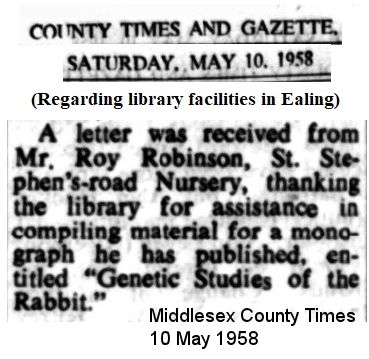
He quickly mastered the basics and Mendel's laws of inheritance and in 1951 his article "Dutch-type white-spotting" in rabbits was published in "Nature." It took him three years to write his first book, "Genetic Studies of the Rabbit," but publishers were not interested in a genetics book hardly best-seller material - by an unknown amateur. Had he been attached to a university department, academic book publishers might have taken an interest. The book was eventually published in 1958 by M. Nijhoff, Hague, but by then he had realised that rabbits were poorly suited to inheritance studies because they did not reach breeding age until 6 months old. He needed an animal that could produce several generations during 6 months, but the study of mice and rats was already monopolised by laboratories.
Robinson also had to teach himself mathematics and statistics as well as genetics. He found those much harder because most textbooks did not show the intermediate stages of complex formulae; "the workings" were things a teacher was expected to demonstrate in the classroom.
Between 1956 to 1958 he took a break from genetics and taught himself economics. He was interested in what is now called macroeconomics, but it was difficult for an amateur to contribute to this field of study so he returned to genetics, finding a better study animal in the Syrian (Golden) Hamster. This had been domesticated in 1931 and in the late 1950s were not yet widespread as pets or research subjects, so Robinson was the first person to study their genetics. He also published papers on other small livestock, including "Mosaicism in Mammals" (Genetica, 1957) and "Sable and Umbrous Mice" (Genetica 1959).
When he married and moved into a smaller house without room for livestock, he turned to the Tiger moth which eventually resulted in "Lepidoptera Genetics," (Pergamon, 1971). A few years later he moved back into his old home at St. Stephen's Nursery and established a hamster colony in a large purpose-built shed. He built up the world's largest collection of hamster mutations and methodically crossed these in various combinations to look for possible genetic linkages. All hamsters were descended from a single female and four males captured near Aleppo, but this small gene pool gave rise to numerous mutations. He was President of the Southern Hamster Club and spoke on hamster colour mutations at their meetings.
He continued to run the nursery businesses at Argyle Road and at St. Stephen's Road until about 1972, first closing the Argyle Road Nursery and then the St. Stephen's Nursery. Ealing had once been noted for horticulture and is still known as the garden of London, but many nurseries were sold off for housing development. St. Stephen's Nursery was a long, rectangular plot of land enclosed within old brick walls. After the business closed, Robinson remained at the nursery, which was allowed to become rundown and become overgrown, with broken-paned greenhouses and plant pots still in situ. The grounds held two large, purpose-built sheds housing hundreds of hamsters in labelled and numbered cages. Robinson's hamster colony was so important that whenever a new mutation was discovered he was sent a breeding pair. His collection contained every known hamster mutation. He interbred them methodically, meticulously documenting the results to ascertain how the mutations were inherited and which were linked. The endnotes list some of his many papers on hamster genetics.
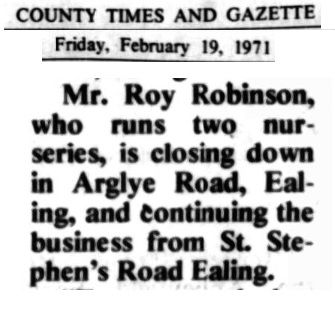
PRODIGIOUS OUTPUT
After a number of papers were published in Genetica in the late 1950s and "Genetic Studies of the Rabbit" was published in 1958,
In 1965 his book "The Genetics of the Norway Rat," was published by Pergamon Press; it had over 1000 references and became the standard text on rat genetics.
In 1966 he became editor of the twice-yearly "Carnivore Genetics Newsletter," set up with American cat geneticist, Dr Neil Todd who was fascinated by cat coat colour frequencies in feline populations around the world. Robinson published several papers on mutant gene frequencies in cat colonies and populations in different regions.
In 1968 he published the "Catalogue & bibliography of canine genetic anomalies" for the Co-operative Hereditary Abnormalities Research Team (CHART), a group of dog breeders aiming to eliminate serious canine genetic diseases through selective breeding.
In 1969 and 1970 Robinson also wrote about the genetics of big cats: "The white tigers of Rewa and Gene Homology in the Felidae" (Genetica, 1969), and "Inheritance of the Black Form of the Leopard Panthera pardus" (Genetica, 1970) and contributed "Genetics of the Black Panther" to Purnell's Encyclopedia.
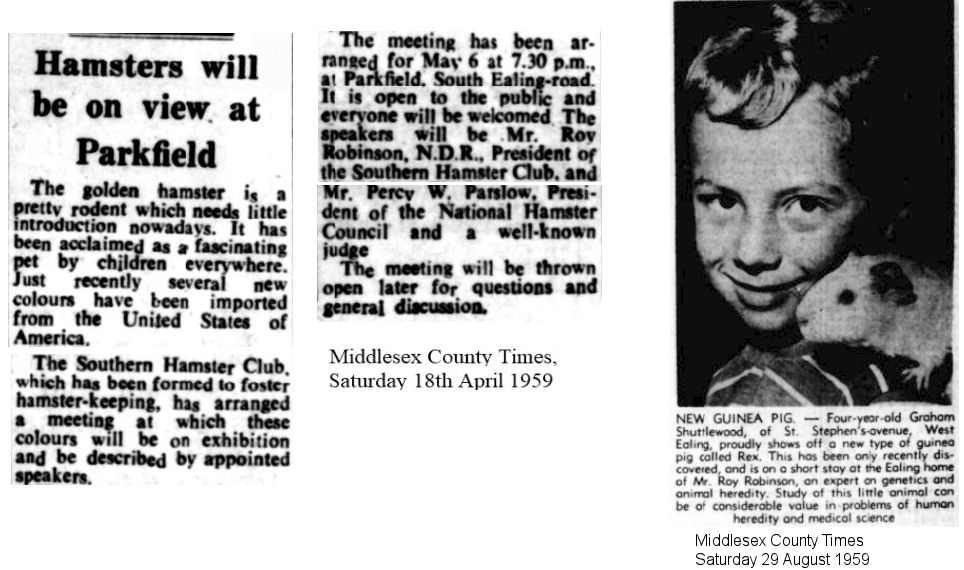
In 1971, "Lepidoptera Genetics" and "Genetics for Cat Breeders" were published and these were followed by a number of genetics books about small livestock and dogs. He revised "Genetics for Cat Breeders" twice, and a fourth edition, edited and updated by 4 experts, was published posthumously as "Robinson's Genetics for Cat Breeders and Veterinarians." It is still considered the standard text for anyone interested in cat genetics.
Robinson collaborated with a large number of breed clubs not just hamsters, but also rabbits, mice, rats, cats, dogs and others - collecting and analysing data on genetic and medical problems in the species or breed. He was listed as a commercial breeder of cats for laboratory use; he studied reproduction in a cat colony over 10 years ("Reproductive performance in a cat colony over a 10-year period" Robinson R, Cox HW. (Lab Anim. 1970). In addition to small livestock, his horticultural background and curiosity identified nine mutations affecting flower colour, leaf colour and growth habit of the Pelargonium (bedding geranium).
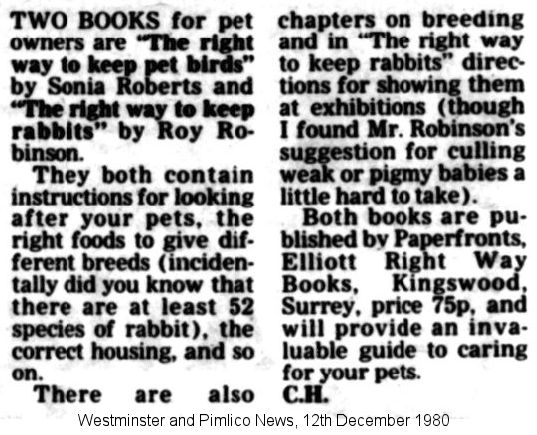
Dog, cat and small livestock breeders frequently asked him to write and advise in their literature. I read his genetics articles in "Our Cats" and "Cats," the latter being the GCCF's official journal. The first editions of "Genetics for Cat Breeders" was published in 1971 and revised in 1977 and 1982. In 1978, "Colour Inheritance in Small Livestock" was published. "Genetics for Dog Breeders" was published in 1982 and revised in 1990.
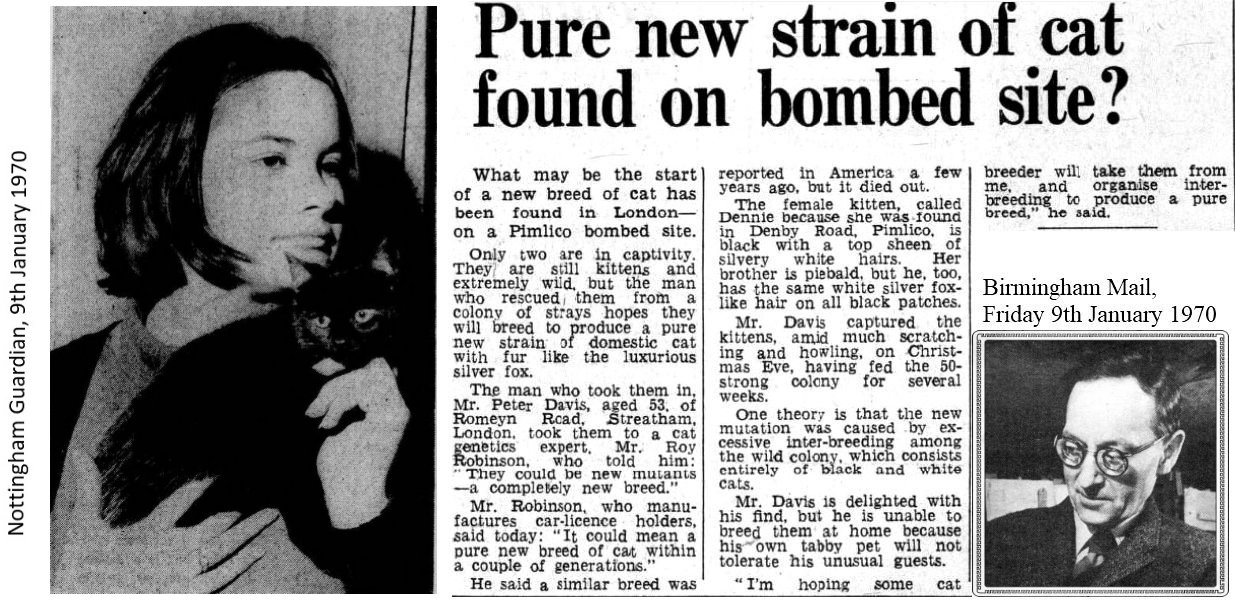
His written output was prodigious: books, revisions to books, scientific papers, magazine articles and responding to letters from clubs, breeders and other researchers. There was also the hamster colony to care for, and breeding experiments to plan, record and analyse.
In recognition of his contribution to animal genetics, Robinson was made a Fellow of the Institute of Biology, which allowed him to make more contacts in his field of study. A number of later papers show him as a co-author alongside authors with more traditional academic qualifications.
Almost up to his death, Robinson worked up to 10 hours every day, which included caring for his study animals. He spent one or two afternoons each week in a library. In the late 1970s, he feared that his work would be badly impacted by the introduction of a 60p fee imposed by his branch library for borrowing journals from the British Lending Library. His scientific papers and reviews might need up to 100 references and he could not afford 60 every time he submitted a paper. Researchers in universities with their own journal collections did not face such hurdles. No doubt many of the journals would have been available in the British Library's National Lending Library for Science and Technology, but this had moved from Woolwich, London to Boston Spa, Yorkshire in 1962, and Robinson disliked travelling. Later on, researchers and animal fanciers around the world would send him papers and articles.
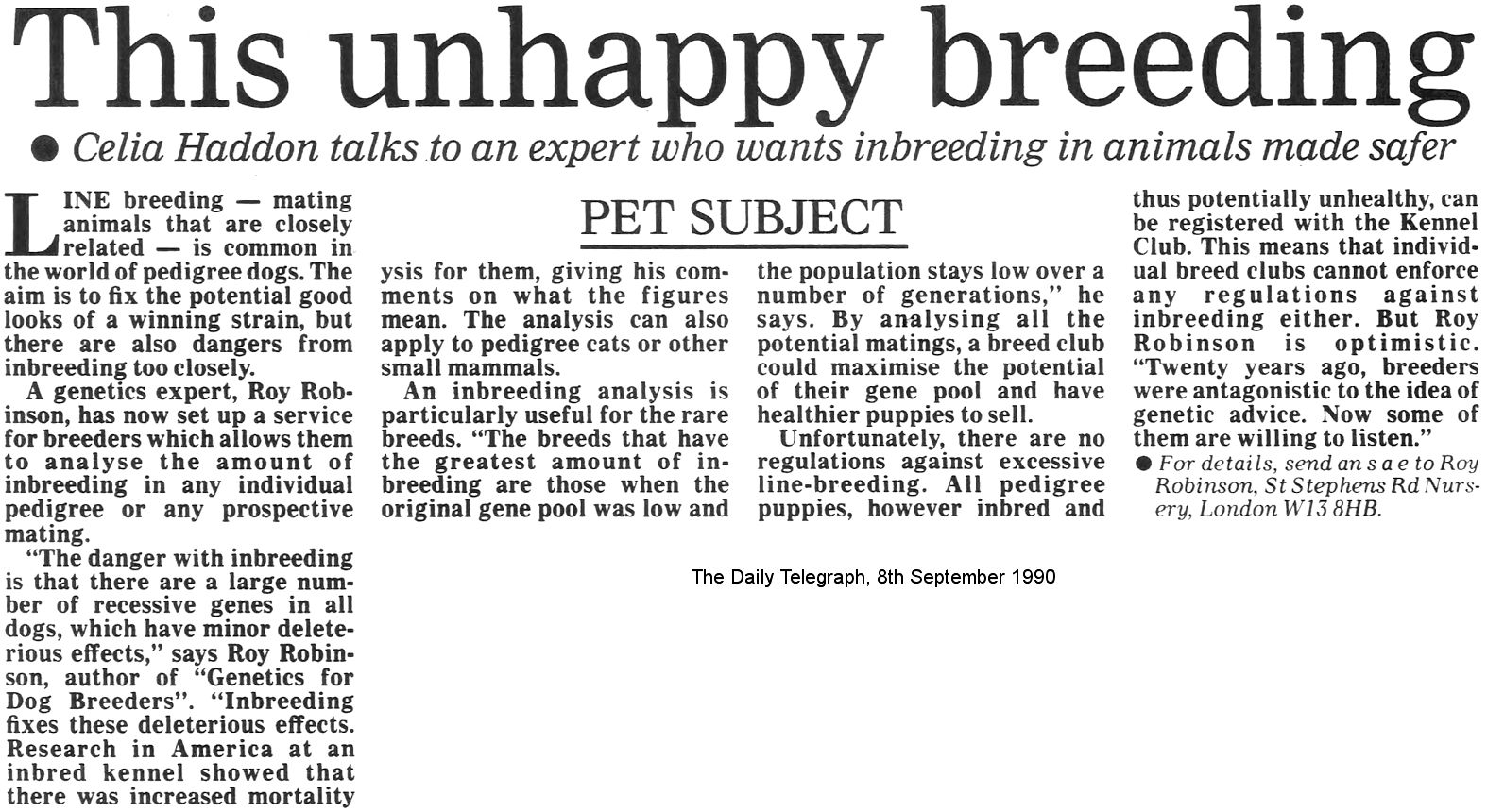
A VERY MODEST MAN
Robinson seemed to collect, compile, collate and cross-reference information. Sometimes there was anecdotal information available. If it conflicted with his own findings, or with scientific papers or principles, he tried to reinterpret the anecdotal information to see if it could be reconciled with the science.
He was always very modest about his contributions to biology and genetics despite having described new mutations in several animals. His books on "Gene Mapping" brought the subject right up to date for the 1970s. Part A gave all the methods and formulae for the biometrical approach and Part B brought together the literature and algebraic formulae on linkage. Robinson was uncertain of its practical application, but knew it brought together information that improved understanding and which might lead to other things. His main motivation for compiling information was curiosity.
Robinson was extremely short-sighted, and his sight continued to deteriorate. Even with his thick glasses he needed to hold text close to his face, and he struggled to see in his final few months, but continued to work long days, every day on his many projects, both in his dimly lit study and in his hamster sheds. His study was full of books on animal genetics, may written or co-authored by Robinson. He died in 1996, with a number of projects still in progress.
I wonder what Robinson would have achieved had he lived in the time of subscription online journals, digitised journals, free scientific papers and other historical archives? What would he have thought of DNA mapping technology? Although the Joint Academic NET existed, the public internet and email (using dial-up modems) were just getting started when Robinson died. Journals were not online in the way they are now.
Through determination, hard study, meticulous record-keeping, correspondence and the pre-internet lending library system, Roy Robinson laid foundations which many others have built upon.
BOOKS (WITH FIRST PUBLICATION DATE)
Genetics of the domestic cat (1959)
Genetics of the Norway Rat (1965)
Right Way to Keep Hamsters and Other Rodents (1967)
Catalogue & bibliography of canine genetic anomalies (1968)
Gene Mapping in Laboratory Mammals Part A (1971)
Gene Mapping in Laboratory Mammals Part B
Genetics for Cat Breeders (1971, 1977, 1982)
Lepidoptera Genetics (1971)
Colour inheritance in small livestock (1978)
The Right way to keep rabbits (1980)
Genetics for Dog Breeders (1982, 1990, 1999)
Robinson's Genetics for Cat Breeders and Veterinarians (1999) published posthumously and updated by Terry W. Stanglein, Carolyn M. Vella, Lorraine M. Shelton, John J. McGonagle
A SELECTION OF PAPERS (WITH JOURNAL NAME & YEAR)
This is just a short list to give an idea of his writings and findings!
RABBITS
"Dutch-type white-spotting" (Nature, 1951)
"Viability of dominant white in the rabbit" (J. Heredity. 1955).
"A linkage test with satin in the rabbit" Spendlove WH, Robinson R. (Genetica. 1970)
HAMSTERS
"Partial albinism in Syrian hamster" (Nature, 1957).
"Two new mutations in the Syrian hamster" (Nature. 1955).
"Genetic studies of the Syrian hamster. III. Variation of dermal pigmentation" (Genetica, 1959)
"Genetic independence of four mutants in the Syrian hamster" (Nature, 1959)
"Occurrence of a brown mutation in the Syrian hamster" (Nature, 1960).
"White band, a new spotting mutation in the Syrian hamster" (Nature, 1960).
"Genetic studies of the Syrian hamster. IV. Brown pigmentation" (Genetica, 1962).
"Genetic studies of the syrian hamster. V White band" (Heredity (Edinb). 1962).
"Color mosaics in Syrian hamsters" (J Hered. 1963).
"Genetic studies of the Syrian hamster. VI. Anophthalmic white" (Genetica. 1964).
"Sex-linked yellow in the Syrian hamster" (Nature. 1966).
"Genetic studies of the Syrian hamster. VII. Independence data" (Heredity (Edinb). 1971)
"Satin - a new coat mutant in the Syrian hamster" (J Hered. 1972).
"Genetic studies of the Syrian hamster. 8. The sex-linked gene tortoiseshell" (Genetica, 1972).
"Linkage of albinism and brown in the Syrian hamster" (J Hered. 1973).
"Linkage of white band and long hair in the Syrian hamster" (J Hered. 1975)
"Genetic studies of the Syrian hamster. X. Rex" (Heredity (Edinb). 1976)
"Linkage group III in the Syrian hamster: linkage between white band and long hair" Robinson R, Peterson JS, Yoon CH. (J Hered. 1978)
"Brown and rust mutants of the Syrian hamster are p and b genes of mammalian coat colors" Robinson R, Beechey CV, Searle AG. (J Hered. 1987)
"Linkage of the satin and umbrous loci in the Syrian hamster" (J Hered. 1988)
"Synergistic action of white spotting genes in the Syrian hamster (Rodentia, Cricetidae)" (Genetica. 1990)
RATS
"Rex mutant in the Norway rat" (J Hered. 1981)
"Genetic linkage in the Norway rat" (Genetica. 1987)
"Linkage studies of wavy in the Norway rat, Rattus norvegicus" (Genetica. 1988)
"An extreme allele of hooded spotting in the Norway rat" (Genetica. 1989)
"Mink and pearl: new color mutants in the Norway rat" (J Hered. 1994)
"Head spot and dilute mutations in the Norway rat" (J Hered. 1998)
OTHER RODENTS
"Sable and umbrous mice" (Genetica 1959)
"A review of genetic linkage in the guinea-pig" (Ann Genet Sel Anim. 1970)
"The agouti alleles of Peromyscus" (J Hered. 1981)
"Gray mutant in the Mongolian gerbil" Leiper BD, Robinson R. (J Hered. 1985)
"Linkage of albino and pink-eyed dilution genes in the Mongolian gerbil and other rodents" Leiper BD, Robinson R. (J Hered. 1986)
"Dominant white spotting in the Chinese hamster" Henwood C, Henwood J, Robinson R. (J Hered. 1987")
"Two recessive rex coat mutants in the guinea pig" Whiteway CE, Robinson R. (J Hered. 1989)
"Albino and pink-eyed dilution mutants in the Russian dwarf hamster Phodopus campbelli" (J Hered. 1996)
CATS
"Genetics of the domestic cat" (Bibliogr Genet. 1959)
"German rex: a rexoid coat mutant in the cat," (Genetica. 1968).
"Mutant gene frequencies in cats of Southern England" (Theor Appl Genet. 1969).
"Hereditary hydrocephalus in the cat" Silson M, Robinson R. (Vet Rec. 1969)
"Reproductive performance in a cat colony over a 10-year period" Robinson R, Cox HW. (Lab Anim. 1970)
"Gene assortment and preferential mating in the breeding of German fancy cats" (Heredity. 1970)
"Cat gene frequencies in Richmond, California" Lamoreux L, Robinson R. (Genetica. 1971)
"The rex mutants of the domestic cat" (Genetica, 1971)
"Oregon rex - a fourth rexoid coat mutant in the cat," (Genetica, 1972)
"Hybrids of wild and domestic cats." (Carnivore Genetics Newsletter. 1972)
"Mutant gene frequencies in cats of Cyprus"(Theor. Appl. Genet. 1972)
"The Canadian hairless or Sphinx cat" (J Hered. 1973).
"Gene frequencies in domestic cats of Greece" Todd NB, Robinson R, Clark JM. (J Hered. 1974)
"Melanin inhibitor: a dominant gene in the domestic cat" Turner P, Robinson R. (J Hered. 1980)
"Cat gene frequencies in cities of the U.S.S.R." R. Robinson G. B. Manchenko (Genetica. 1981)
"Gene frequencies in a population of feral cats in Portsmouth naval Dockyard" Dards JL, Robinson R. (Theor Appl Genet. 1983)
"Mutant gene frequencies in cats of the greater London area" (Theor Appl Genet. 1987)
"Tabby pattern alleles of the domestic cat" Lomax TD, Robinson R. (J Hered. 1988)
"The American curl cat" (J Hered. 1989)
"'Spasticity' in the Devon rex cat" (Vet Rec. 1992)
"Expressivity of the Manx gene in cats" (J Hered. 1993)
DOGS
"Relationship between litter size and weight of dam in the dog" (Vet Rec. 1973)
"Genetic aspects of umbilical hernia incidence in cats and dogs" (Vet Rec. 1977)
"Chinese crested dog" (J Hered. 1985)
"Inheritance of colour and coat in the Belgian Shepherd dog" (Genetica. 1988)
"Harlequin colour in the Great Dane dog" O'Sullivan N, Robinson R. (Genetica. 1988)
"Inheritance of colour and coat in the Belgian Shepherd dog" (Genetica. 1988)
"Inheritance of coat colour in the Anatolian shepherd dog" (Genetica. 1989)
MISC
"Mosaicism in Mammals" (Genetica, 1957)
"The white tigers of Rewa and gene homology in the Felidae" (Genetica, 1969)
"Inheritance of the black form of the leopard Panthera pardus" (Genetica, 1970)
"Genetic defects in the pig" (J. Animal Breeding & Genetics. 1991)